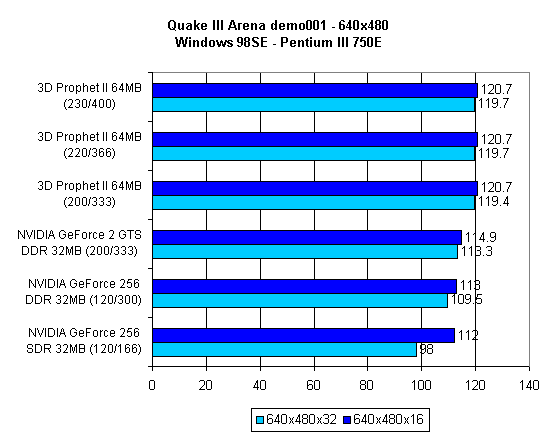3d Prophet Ii Gts 64mb Driver
It was canceled because it didn't offer enough performance improvement to catch-up with the GeForce 3, let-alone the GeForce 4 released that year. It was just an overclocked version (15% faster) of thew same core.The previous model matched the Geforce 2 GTS, and lagged the Ultra and Geforce 3.The GeForce 4 MX 440 was a little slower than the GeForce 3 in DX7 games, so that would have been it's competition IN OLDER GAMES. With no hardware T&L in 2002, it would have been dead-in-the-water with games like Battlefield 1942 and Halo 1 thirsty for hardware lighting.It was a one-trick pony just like the Voodoo 5. PowerVR only survived because they had no need to figure out how T&L worked until the smartphone revolution.

The original Kyro was considered a budget GPU. It was definitely a thing you could buy for a while.The hype for the Kyro II was probably so short lived, most have never heard of it. If there was any hype, I don't recall any from memory.Kyro II was too late to the party, as by the time it launched (if seems that it didn't really launch), it was a generation behind. Back then, things were so fiercely competitive, that being a generation behind was pretty much fatal.The Matrox Parhelia suffered a similar fate.Yet another obscure-yet-failed-to-market-gpu for collectors. A second refresh of the KYRO was planned for 2002, the STG4800 KYRO II SE.
Samples of this card were sent to reviewers but it does not appear to have been brought to market. Apart from a clockspeed boost, this refresh was announced with a 'EnT&L' HW T&L software emulation, which eventually made it into the drivers for the previous KYRO cards starting with version 2.0. The STG5500 KYRO III, based upon the next-generation PowerVR4, was completed and would have included hardware T&L but was shelved due to STMicro closing its graphics division. Here's a now ancient Anandtech review of the Kyro II 64MB circa 2001.Mind you, this is not the exact same card this thread is discussing, but they are very similar since they are from the same family.I found this bit from the PowerVR Wikipedia entry rather interesting:Compared to the competition, Kyro II does really well at 640x480:But the performance tanks, embarrassingly so, once you crank the resolution. Mind you, that back then running things at 16-bit gave a significant performance boost to pretty much all the big three's products.

The Kyro II, however, ran 16-bit equally slow as its 32-bit, which was viewed as a failure back then. By today's standards, we'd have been more forgiving of this.And now we see why Kyro II was considered a budget card back then.
Its original asking price was $200. For comparison, I think I paid $400 for a GeForce 2 GTS 64 MB at launch back then, which was a lot of money for a gpu. (I recall paying $180 for a Voodoo 1 and $250 for a 12MB Voodoo2 at launch)Kyro II would have made sense for someone who couldn't budget more than $200, especially if their 15' CRT could only do 640x480 or 800x600 anyway.Tile based rendering was so hype back then. Sadly it was never the panacea they made it out to be.
It didn't help that the Kyro II was being held back by its peasant 128-bit bus. Bandwidth woes, indeed. Click to expand.By most accounts, the Kyro II's 16-bit looked better than the competition's. 3dfx used to tout how their 16-bit dithering was superior to everyone's and really looked more like simulated 22-bit color.I think most consumers cared more about the fps back then than color depth.

Personally, I couldn't wait for 32-bit color to go mainstream. Unfortunately, Kyro II came out around the time that 16-bit was on its way out.I didn't start appreciating 32-bit color until I went with a nice 22' Iiyama flat CRT with component BNC driven by a Matrox G400 MAX. Those were glorious days. I don't miss 16-bit color at all. By most accounts, the Kyro II's 16-bit looked better than the competition's.
3dfx used to tout how their 16-bit dithering was superior to everyone's and really looked more like simulated 22-bit color.I think most consumers cared more about the fps back then than color depth. Personally, I couldn't wait for 32-bit color to go mainstream. Unfortunately, Kyro II came out around the time that 16-bit was on its way out.I didn't start appreciating 32-bit color until I went with a nice 22' Iiyama flat CRT with component BNC driven by a Matrox G400 MAX.
Those were glorious days. I don't miss 16-bit color at all. Better RAMDAC's helped with the V1 and V2 but they still suffered.I have a Kyro 2 somewhere in the pile. Used it for a while then went back to my V5 5500AGP. In games where the culling feature of the GPU worked correctly it was great but they were far and few between in reality and nV and ATi were already adding macro/micro-tiling to their stuff anyways. Playing with some of the driver options for the old Radeon 64MB DDR VIVO SE I had after the V5 5500 netted some pretty decent performance increases back then, plus it overclocked like a champ. Better RAMDAC's helped with the V1 and V2 but they still suffered.I have a Kyro 2 somewhere in the pile.
Hercules 3d Prophet Ii Gts 64mb Driver
Used it for a while then went back to my V5 5500AGP. In games where the culling feature of the GPU worked correctly it was great but they were far and few between in reality and nV and ATi were already adding macro/micro-tiling to their stuff anyways. Playing with some of the driver options for the old Radeon 64MB DDR VIVO SE I had after the V5 5500 netted some pretty decent performance increases back then, plus it overclocked like a champ.